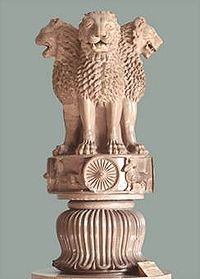
Sarnath Museum
Encyclopedia
Museum at Sarnath is museum that houses the findings and excavations at Sarnath
, by the Archaeological Survey of India
, close to archaeological site.
 Sarnath
Sarnath
has yielded a rich collection of sculptures, artifacts and edifices comprising numerous Buddha
and Bodhisattva
images and other ancient remains. Finest specimens of Buddhist art and other important remains have been housed at the museum.
While the single most famous exhibit of this museum is the Lion Capital of Asoka
, the Sarnath museum has a small but awe-inspiring collection of Buddhist artifacts. Among the things to see is a beautiful sculpture of the Buddha from the fifth century. The Buddha sits cross-legged, with eyes downcast in deep meditation, and a halo around his head. Also worth exploring are several beautiful figures of the bodhisattvas.
Of other Buddhist remains there is an impressive and amazingly beautiful, life-size standing Bodhisattva and a delicate image of the Bodhisattva with a lotus and yet another bronze sculpture showing the Bodhisattva with multiple arms. The museum at Sarnath also houses an excellent collection of figures and sculptures from the Mauryan, the Kushana and the Gupta periods. Prominent of them is the earliest Buddha image found at Sarnath and many images of Hindu Gods dating from the 9th to 12th centuries.
The main attraction of the Sarnath Archaeological Museum is the superb Ashokan Pillar
. It has four back-to-back lions, which has been adopted as the National symbol of India. Below this are representations of a lion, an elephant, horse and the bull.
Sarnath
Sarnath or Sārnātha is the deer park where Gautama Buddha first taught the Dharma, and where the Buddhist Sangha came into existence through the enlightenment of Kondanna. Sarnath is located 13 kilometres north-east of Varanasi, in Uttar Pradesh, India...
, by the Archaeological Survey of India
Archaeological Survey of India
The Archaeological Survey of India is a department of the Government of India, attached to the Ministry of Culture . The ASI is responsible for archaeological studies and the preservation of archaeological heritage of the country in accordance with the various acts of the Indian Parliament...
, close to archaeological site.
Overview

Sarnath
Sarnath or Sārnātha is the deer park where Gautama Buddha first taught the Dharma, and where the Buddhist Sangha came into existence through the enlightenment of Kondanna. Sarnath is located 13 kilometres north-east of Varanasi, in Uttar Pradesh, India...
has yielded a rich collection of sculptures, artifacts and edifices comprising numerous Buddha
Buddha
In Buddhism, buddhahood is the state of perfect enlightenment attained by a buddha .In Buddhism, the term buddha usually refers to one who has become enlightened...
and Bodhisattva
Bodhisattva
In Buddhism, a bodhisattva is either an enlightened existence or an enlightenment-being or, given the variant Sanskrit spelling satva rather than sattva, "heroic-minded one for enlightenment ." The Pali term has sometimes been translated as "wisdom-being," although in modern publications, and...
images and other ancient remains. Finest specimens of Buddhist art and other important remains have been housed at the museum.
While the single most famous exhibit of this museum is the Lion Capital of Asoka
Lion Capital of Asoka
The Lion capital of Ashoka is a sculpture of four "Indian lions" standing back to back. It was originally placed atop the Aśoka pillar at Sarnath, now in the state of Uttar Pradesh, India by Emperor Ashoka circa 250 BC. The pillar, sometimes called the Aśoka Column is still in its original...
, the Sarnath museum has a small but awe-inspiring collection of Buddhist artifacts. Among the things to see is a beautiful sculpture of the Buddha from the fifth century. The Buddha sits cross-legged, with eyes downcast in deep meditation, and a halo around his head. Also worth exploring are several beautiful figures of the bodhisattvas.
Of other Buddhist remains there is an impressive and amazingly beautiful, life-size standing Bodhisattva and a delicate image of the Bodhisattva with a lotus and yet another bronze sculpture showing the Bodhisattva with multiple arms. The museum at Sarnath also houses an excellent collection of figures and sculptures from the Mauryan, the Kushana and the Gupta periods. Prominent of them is the earliest Buddha image found at Sarnath and many images of Hindu Gods dating from the 9th to 12th centuries.
The main attraction of the Sarnath Archaeological Museum is the superb Ashokan Pillar
Pillars of Ashoka
The pillars of Ashoka are a series of columns dispersed throughout the northern Indian subcontinent, erected or at least inscribed by the Mauryan king Ashoka during his reign in the 3rd century BCE. Originally, there must have been many pillars but only nineteen survive with inscriptions. Many are...
. It has four back-to-back lions, which has been adopted as the National symbol of India. Below this are representations of a lion, an elephant, horse and the bull.

